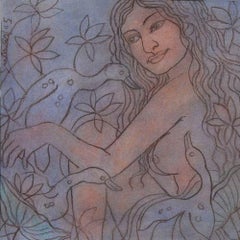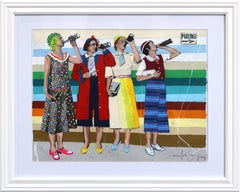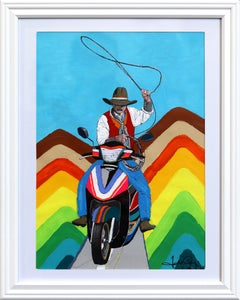Conté Figurative Paintings
to
1
Overall Width
to
Overall Height
to
1
1
1
221
31
17
16
10
47
9
2
2
1
Medium: Conté
Artist: Suhas Roy
Radha, Tempera Coloured Conte on Pastel on Paper by Artist Suhas Roy "In Stock"
By Suhas Roy
Located in Kolkata, West Bengal
Suhas Roy - Radha - 20 x 20 inches ( unframed size)
Tempera Coloured Conte on Pastel on Paper , 2005
Suhas Roy 's mystic woman which he calls 'Radha', either Oil on canvas or sof...
Category
Early 2000s Modern Conté Figurative Paintings
Materials
Pastel, Board, Paper, Conté, Tempera
Related Items
Empowering #20 - Original Colorful Quirky Women Figurative Mixed Media Artwork
Located in Los Angeles, CA
Italian artist Fabio Coruzzi merges painting and photography into one imaginative image that offers a new outlook on an otherwise ordinary urban scene. His artworks represent an auth...
Category
21st Century and Contemporary Pop Art Conté Figurative Paintings
Materials
Paper, Oil Pastel, Pastel, Mixed Media, Acrylic
Urban Cowboy #2 - Original Colorful Rainbow Quirky Figurative Mixed Media Art
Located in Los Angeles, CA
Italian artist Fabio Coruzzi merges painting and photography into one imaginative image that offers a new outlook on an otherwise ordinary urban scene. His artworks represent an auth...
Category
21st Century and Contemporary Pop Art Conté Figurative Paintings
Materials
Paper, Oil Pastel, Mixed Media, Acrylic, Pastel
The Pavement #2 - Original Colorful Quirky Urban Figurative Mixed Media Artwork
Located in Los Angeles, CA
Italian artist Fabio Coruzzi merges painting and photography into one imaginative image that offers a new outlook on an otherwise ordinary urban scene. His artworks represent an auth...
Category
21st Century and Contemporary Pop Art Conté Figurative Paintings
Materials
Paper, Oil Pastel, Pastel, Mixed Media, Acrylic, Wood, Cardboard, Gel Pen
"Safety Focused" - Original Street Art Painting by Leading Pop Artist Gary John
By Gary John
Located in Los Angeles, CA
Los Angeles street artist Gary John exploded onto the international art scene first during Art Basel Miami in 2013. John’s playfully bold work quickly gained attention and he was nam...
Category
21st Century and Contemporary Street Art Conté Figurative Paintings
Materials
Acrylic Polymer, Board, Mixed Media, Pastel, Newsprint, Graphite
$640 Sale Price
20% Off
H 28 in W 22 in
Portrait of My Barber (At The Barber Shop) - 21st Century, Contemporary, Africa
Located in Ibadan, Oyo
Shipping Procedure
FREE Shipping Worldwide
Ships in a well-protected tube.
This work is unique, not a print or other type of copy.
Accompanied by a Certificate of Authenticity.
Abou...
Category
21st Century and Contemporary Realist Conté Figurative Paintings
Materials
Canvas, Pastel, Ink, Acrylic, Mixed Media
Eyitayo Alagbe Portrait of My Barber (At The Barber Shop) - 21st Century, Contemporary, Africa, 2023
$3,400 Sale Price
20% Off
H 48 in W 36 in D 1 in
Rhythm of Hope -21st Century, Contemporary, Neo-Expressionism, Mixed Media Music
Located in Ibadan, Oyo
Shipping Procedure
Ships in a well-protected tube from Nigeria
This work is unique, not a print or other type of copy.
Accompanied by a Certificate of Authenticity (Issued by the Gal...
Category
20th Century Neo-Expressionist Conté Figurative Paintings
Materials
Charcoal, Pastel, Acrylic, Cardboard
Fredrick IdeleRhythm of Hope -21st Century, Contemporary, Neo-Expressionism, Mixed Media Music, 2023
$1,680 Sale Price
20% Off
H 24 in W 18 in D 1 in
Original Bruno SamMartino vs. Baron Mikel Scicluna 2
By LeRoy Neiman
Located in Saint Petersburg, FL
LeRoy Neiman Original Mixed media on paper; including tempera, acrylic, pastel, watercolor, and conte' crayon
Dated 1966
8 1/2″ x 16 1/4″ viewab...
Category
1960s American Impressionist Conté Figurative Paintings
Materials
Conté, Pastel, Mixed Media, Tempera, Watercolor
"Wanderer Study 2" Acrylic, Pastel and Collaged Painting of Moving House
By Seth Clark
Located in Philadelphia, PA
This piece, titled "Wanderer Study 2"is an original artwork by Seth Clark as part of his newest solo exhibition, "Passing Through". made of collage, charcoal, pastel, acrylic, and gr...
Category
21st Century and Contemporary Contemporary Conté Figurative Paintings
Materials
Wood, Paper, Charcoal, Pastel, Acrylic, Graphite
Life as a Roller-coaster 1 - 21st Century, Contemporary, Figurative, Men Skating
Located in Ibadan, Oyo
Struggle teaches you a lot of things, and I am happy that I witnessed a roller coaster ride. The journey has improved me as a person and made me more mature.
Life is like a roller co...
Category
21st Century and Contemporary Contemporary Conté Figurative Paintings
Materials
Canvas, Pastel, Ink, Acrylic
$4,080 Sale Price
20% Off
H 60 in W 48 in D 1 in
Yoga Feelings On My Vintage Jacket
Located in Ibadan, Oyo
Alagbe's artwork draws attention to the man's jacket, which showcases his bare chest. The jacket, reminiscent of a vintage style, represents the layers we often wear to shield ourselves from the world. By revealing his bare chest, the man symbolizes a willingness to be vulnerable and open to self-exploration. The jacket becomes a canvas for introspection, encouraging viewers to reflect on their own inner journeys toward peace and self-discovery.
The quote by Geshe Kelsang Gyatso, "We all wish for world peace, but world peace will never be achieved unless we first establish peace within our own minds," resonates deeply with Alagbe's artwork. It highlights the idea that true peace cannot be attained externally unless we find serenity within ourselves. The artwork invites viewers to examine their own inner landscape and cultivate a sense of harmony, balance, and compassion toward themselves and others.
Embedded within the artwork is another profound quote, this time from The Bhagavad Gita...
Category
21st Century and Contemporary Modern Conté Figurative Paintings
Materials
Canvas, Pastel, Ink, Acrylic
$4,080 Sale Price
20% Off
H 60 in W 48 in D 1 in
Couple Sitting Among Lanterns, Cover for Vanity Fair
Located in Fort Washington, PA
Medium: Pastel, Gouache, and Black Crayon on Paperboard
Sight Size 22.88" x 17.50", Framed 31.75" x 26.50"
Signature: Signed EVERETT SHINN and Dated
Vanity Fair Cover...
Category
1910s Conté Figurative Paintings
Materials
Crayon, Pastel, Gouache, Board
Life as a Roller-coaster 2 - 21st Century, Contemporary, Figurative, Men Skating
Located in Ibadan, Oyo
Struggle teaches you a lot of things, and I am happy that I witnessed a roller coaster ride. The journey has improved me as a person and made me more mature.
Life is like a roller co...
Category
21st Century and Contemporary Contemporary Conté Figurative Paintings
Materials
Canvas, Pastel, Ink, Acrylic
$4,080 Sale Price
20% Off
H 60 in W 48 in D 1 in
Conté figurative paintings for sale on 1stDibs.
Find a wide variety of authentic Conté figurative paintings available on 1stDibs. While artists have worked in this medium across a range of time periods, art made with this material during the 21st Century is especially popular. If you’re looking to add figurative paintings created with this material to introduce a provocative pop of color and texture to an otherwise neutral space in your home, the works available on 1stDibs include elements of purple, yellow and other colors. There are many well-known artists whose body of work includes ceramic sculptures. Popular artists on 1stDibs associated with pieces like this include Sanatan Dinda, Jack Hooper, Suhas Roy, and Bren Bauer. Frequently made by artists working in the Contemporary, Modern, all of these pieces for sale are unique and many will draw the attention of guests in your home. Not every interior allows for large Conté figurative paintings, so small editions measuring 0.1 inches across are also available


